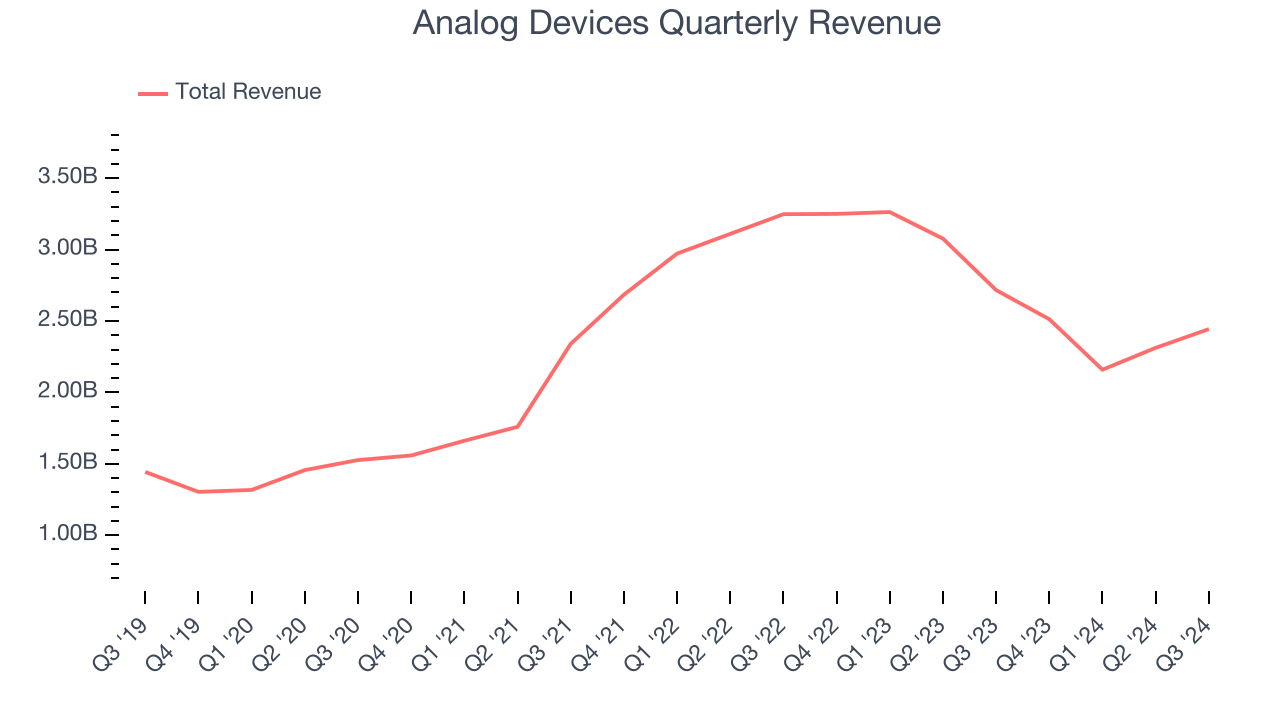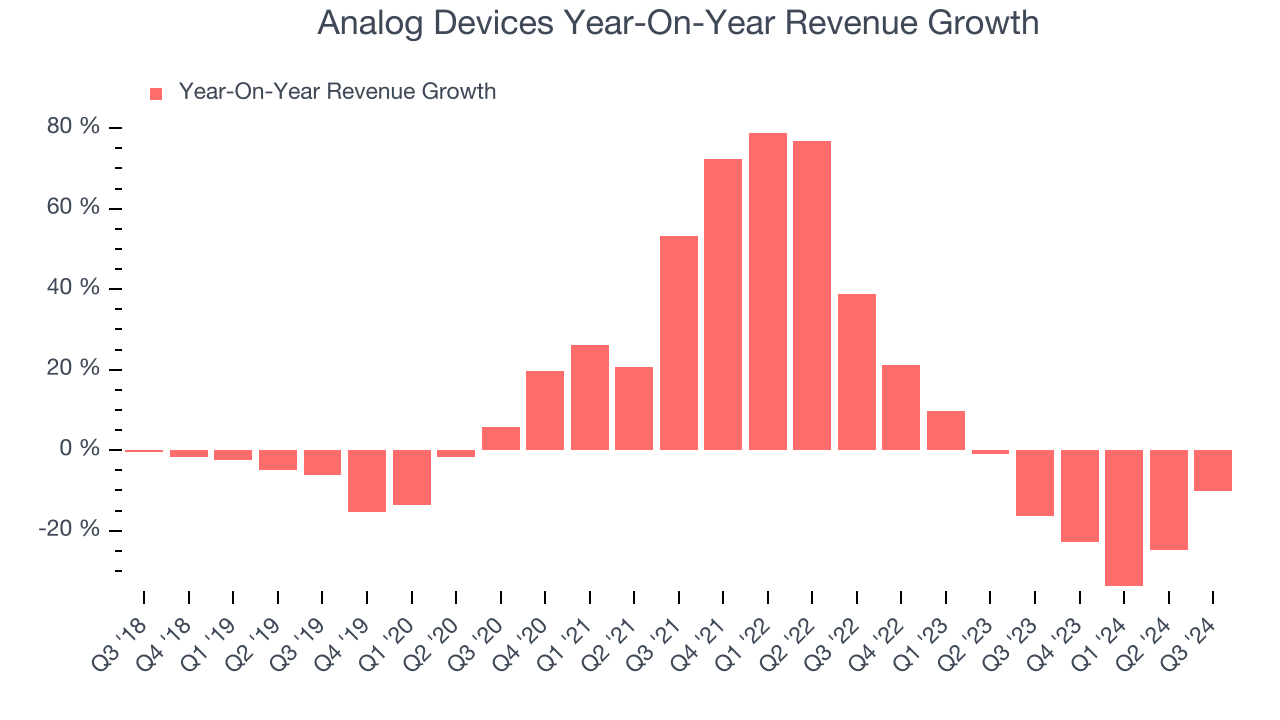
Manufacturer of analog chips, Analog Devices (NASDAQ:ADI) beat Wall Street’s revenue expectations in Q3 CY2024, but sales fell by 10.1% year on year to $2.44 billion. The company expects next quarter’s revenue to be around $2.35 billion, close to analysts’ estimates. Its non-GAAP profit of $1.67 per share was 1.6% above analysts’ consensus estimates.
Is now the time to buy Analog Devices? Find out by accessing our full research report, it’s free.
Analog Devices (ADI) Q3 CY2024 Highlights:
- Revenue: $2.44 billion vs analyst estimates of $2.41 billion (10.1% year-on-year decline, 1.6% beat)
- Adjusted EPS: $1.67 vs analyst estimates of $1.64 (1.6% beat)
- Adjusted Operating Income: $1.00 billion vs analyst estimates of $988.1 million (41.1% margin, 1.7% beat)
- Revenue Guidance for Q4 CY2024 is $2.35 billion at the midpoint, roughly in line with what analysts were expecting
- Adjusted EPS guidance for Q4 CY2024 is $1.53 at the midpoint, below analyst estimates of $1.57
- Operating Margin: 23.3%, in line with the same quarter last year
- Free Cash Flow Margin: 36.2%, up from 26.2% in the same quarter last year
- Inventory Days Outstanding: 128, down from 130 in the previous quarter
- Market Capitalization: $111 billion
"ADI's revenue, profitability, and earnings per share all finished above our guided midpoint, underscoring continued business momentum and solid execution," said Vincent Roche, CEO and Chair.
Company Overview
Founded by two MIT graduates, Ray Stata and Matthew Lorber in 1965, Analog Devices (NASDAQ:ADI) is one of the largest providers of high performance analog integrated circuits used mainly in industrial end markets, along with communications, autos, and consumer devices.
Analog Semiconductors
Demand for analog chips is generally linked to the overall level of economic growth, as analog chips serve as the building blocks of most electronic goods and equipment. Unlike digital chip designers, analog chip makers tend to produce the majority of their own chips, as analog chip production does not require expensive leading edge nodes. Less dependent on major secular growth drivers, analog product cycles are much longer, often 5-7 years.
Sales Growth
Examining a company’s long-term performance can provide clues about its quality. Any business can put up a good quarter or two, but the best consistently grow over the long haul. Luckily, Analog Devices’s sales grew at a decent 9.5% compounded annual growth rate over the last five years. Its growth was slightly above the average semiconductor company and shows its offerings resonate with customers. Semiconductors are a cyclical industry, and long-term investors should be prepared for periods of high growth followed by periods of revenue contractions.

We at StockStory place the most emphasis on long-term growth, but within semiconductors, a half-decade historical view may miss new demand cycles or industry trends like AI. Analog Devices’s recent history marks a sharp pivot from its five-year trend as its revenue has shown annualized declines of 11.4% over the last two years. 
This quarter, Analog Devices’s revenue fell by 10.1% year on year to $2.44 billion but beat Wall Street’s estimates by 1.6%. Company management is currently guiding for a 6.5% year-on-year decline in sales next quarter.
Looking further ahead, sell-side analysts expect revenue to grow 8.6% over the next 12 months, an improvement versus the last two years. This projection is above average for the sector and indicates its newer products and services will spur faster growth.
Here at StockStory, we certainly understand the potential of thematic investing. Diverse winners from Microsoft (MSFT) to Alphabet (GOOG), Coca-Cola (KO) to Monster Beverage (MNST) could all have been identified as promising growth stories with a megatrend driving the growth. So, in that spirit, we’ve identified a relatively under-the-radar profitable growth stock benefitting from the rise of AI, available to you FREE via this link.
Product Demand & Outstanding Inventory
Days Inventory Outstanding (DIO) is an important metric for chipmakers, as it reflects a business’ capital intensity and the cyclical nature of semiconductor supply and demand. In a tight supply environment, inventories tend to be stable, allowing chipmakers to exert pricing power. Steadily increasing DIO can be a warning sign that demand is weak, and if inventories continue to rise, the company may have to downsize production.

This quarter, Analog Devices’s DIO came in at 128, which is 9 days above its five-year average. These numbers suggest that despite the recent decrease, the company’s inventory levels are higher than what we’ve seen in the past.
Key Takeaways from Analog Devices’s Q3 Results
It was encouraging to see Analog Devices beat analysts’ adjusted operating income expectations this quarter. We were also happy its EPS outperformed Wall Street’s estimates. Next quarter's revenue guidance was in line, which is comforting given some of the missed by semiconductor peers this quarter. Overall, this quarter had some key positives. The stock traded up 5.6% to $236.30 immediately following the results.
So do we think Analog Devices is an attractive buy at the current price? The latest quarter does matter, but not nearly as much as longer-term fundamentals and valuation, when deciding if the stock is a buy. We cover that in our actionable full research report which you can read here, it’s free.
